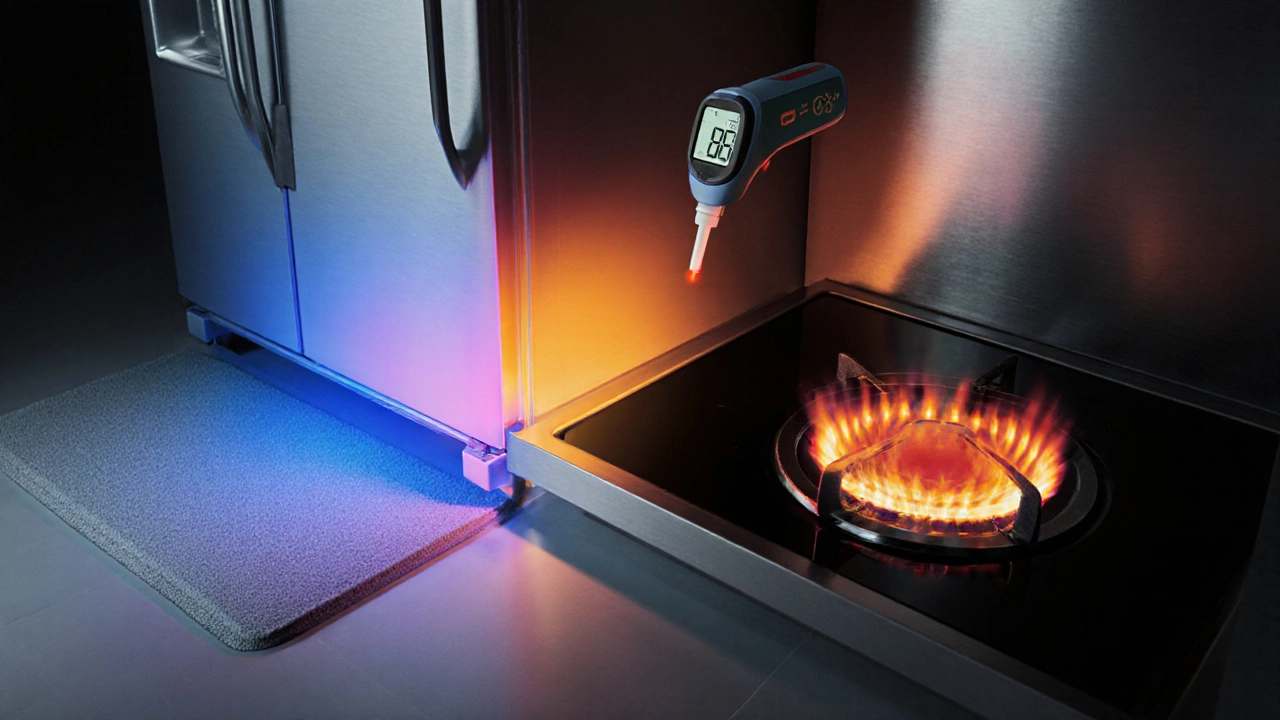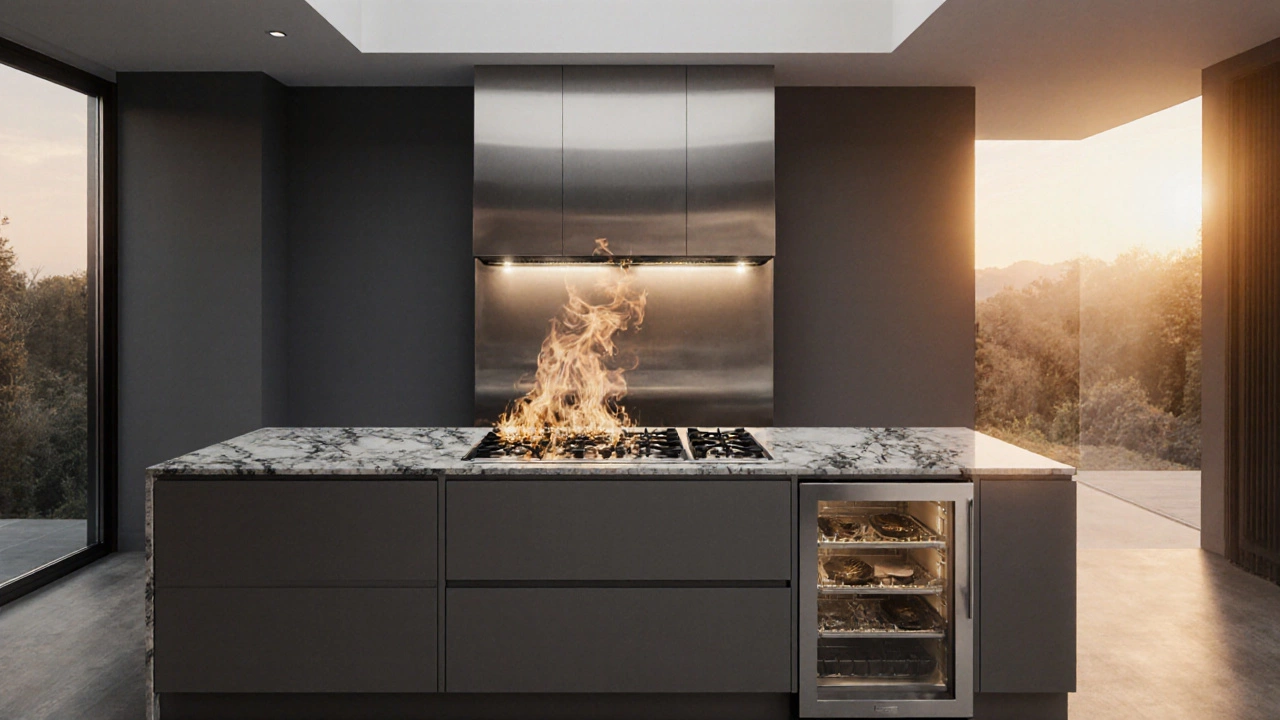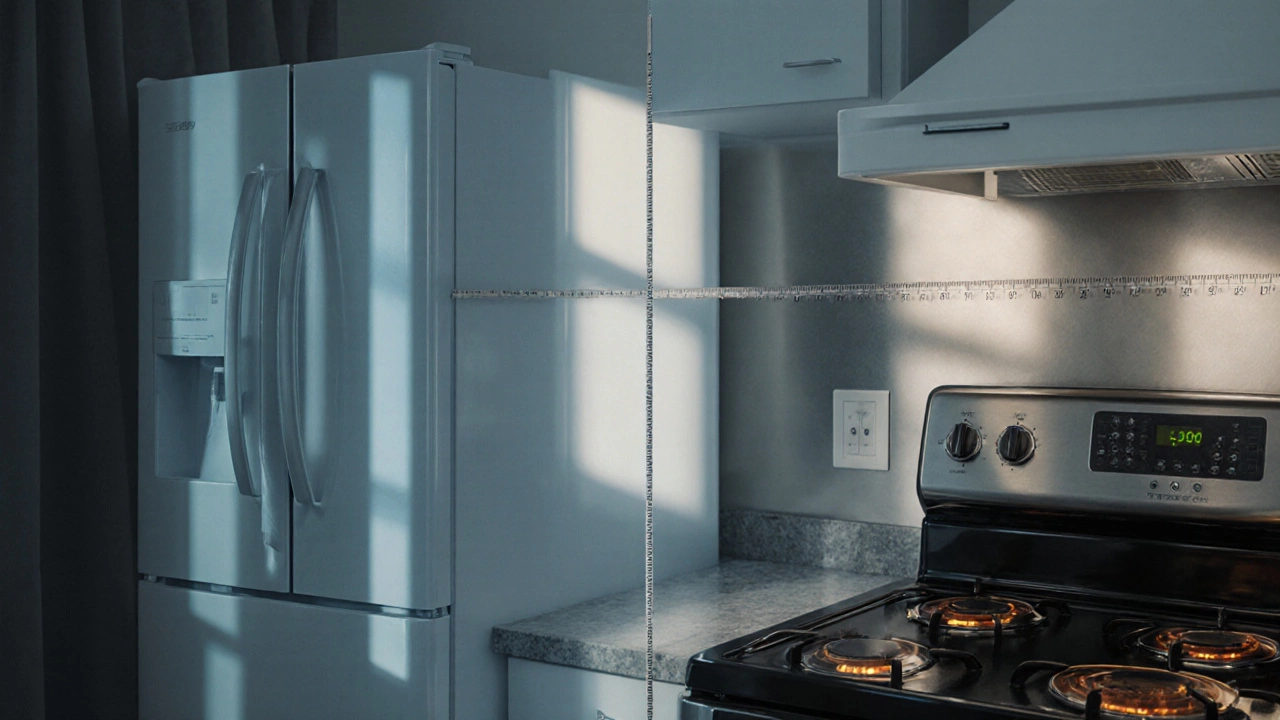Refrigerator-Stove Clearance Calculator
Quick Take
- Yes, you can put a refrigerator next to a stove, but you need proper clearance.
- Minimum clearance is 2‑3 inches for electric or induction ranges, and 3‑6 inches for gas.
- Heat, moisture, and vibration are the main risks to watch.
- Local building codes often cite a 12‑inch fire‑clearance rule for gas appliances.
- Use heat‑deflecting mats or a backsplash to protect the fridge door.
Placing a refrigerator next to stove might seem like a space‑saving hack, but it raises a few practical questions. Will the heat make the fridge work harder? Could it damage the finish? And what do the codes say? This guide walks you through the safety facts, the exact distances you should keep, and smart design tricks that let you keep both appliances close without compromising efficiency.
Understanding the Issue
When you line up a refrigerator is an insulated box that keeps food cold using a compressor and refrigerant cycle next to a stove a heat‑producing cooking appliance that can be gas, electric or induction, the two machines share a wall, a corner, or even a single side panel. The stove generates heat, moisture, and sometimes grease vapors, while the fridge relies on a stable, cool environment to run efficiently.
Three forces matter most:
- Heat transfer: Excess heat raises the fridge’s ambient temperature, forcing the compressor to run longer.
- Moisture and grease: Splatter can coat the fridge’s door gasket, leading to sealing problems.
- Vibration: Gas burners and powerful burners create slight vibrations that may loosen shelf brackets over time.
Ignoring these factors can increase your energy bill by up to 15% and shorten the fridge’s lifespan by several years.
Safety & Heat Considerations
Heat is the biggest enemy. Most manufacturers rate their fridges for an ambient temperature of 95°F (35°C). If the stove’s surface reaches 500°F (260°C) during cooking, the surrounding air can quickly climb above the fridge’s safe range, especially if the appliances share a narrow gap.
Here’s what happens inside the fridge when it’s exposed to extra heat:
- The thermostat senses a higher temperature.
- The compressor turns on more often, drawing more electricity.
- Internal components warm up, increasing wear and the likelihood of component failure.
For gas stoves, many local fire departments require a 12‑inch fire‑clearance zone between the burner and any combustible surface, including a refrigerator door.

Clearance Guidelines (With Table)
Clearance distances vary by stove type and manufacturer recommendations. The table below summarizes the most common guidelines you’ll find in user manuals and building codes.
| Stove Type | Minimum Horizontal Gap | Vertical Gap (if stacked) | Extra Protection Needed? |
|---|---|---|---|
| Electric coil or radiant | 2‑3 inches | None | Heat‑deflecting mat |
| Induction | 2‑3 inches | None | Optional backsplash |
| Gas (standard burners) | 3‑6 inches | 12 inches (fire‑clearance) | Fire‑rated backsplash |
| Wall‑oven or double‑stack | 4‑6 inches | 12‑18 inches | Heat‑shield panel |
Even if you meet the minimum distance, adding a heat‑reflective barrier-such as a ¼‑inch stainless steel backsplash-helps keep the fridge’s side panel cool.
Design Tips & Alternatives
If you love a tight‑kitchen feel, try these layout tricks:
- Shift the fridge slightly forward so its door opens away from the stove, reducing exposure to heat.
- Use a pull‑out fridge drawer that sits beneath the countertop, keeping the compressor farther from the burner.
- Install a vented cabinet above the stove; it draws hot air upward, away from the fridge.
- Choose a low‑profile fridge with a rear‑mounted compressor, which runs cooler than side‑mounted units.
When space is at a premium, a kitchen island a central work surface that can house appliances can separate the two devices while still keeping the workflow efficient. Place the fridge on one side of the island and the stove on the other, using the island as a buffer.
Building Code Overview
Most US building codes reference the International Residential Code (IRC) or International Mechanical Code (IMC). The relevant excerpt for appliance placement reads:
"Combustible materials shall not be installed within 12 inches of the top, sides, or front of a gas‑fired appliance unless a fire‑rated barrier is provided."
Electric and induction ranges are usually exempt from the strict 12‑inch rule, but local jurisdictions may still enforce a minimum clearance for safety. Always check the city’s Department of Buildings or your homeowner’s association guidelines before finalizing the layout.
Another code element is the clearance distance the measured space required between heat‑producing appliances and nearby objects for ventilation. It ensures that hot air can escape without building up around other appliances.
Troubleshooting & What to Do If Already Installed
Real‑world kitchens often end up with the fridge hugging the stove. If you’re already in that spot, follow these steps:
- Check the fridge’s temperature: Keep the internal temp at 37‑40°F (3‑4°C) for fresh foods. If it’s higher, you’re losing efficiency.
- Measure the ambient temperature on the fridge side wall with an infrared thermometer. Anything above 85°F (29°C) indicates insufficient clearance.
- Add a heat‑shield: Attach a stainless‑steel or ceramic tile backsplash covering at least the height of the stove’s burner zone.
- Seal any gaps: Use high‑temperature silicone caulk around the joint to block warm air.
- Consider relocation: If the fridge runs continuously (more than 30% of the time), moving it even 6 inches farther can cut energy usage by 5‑10%.
Remember to recalibrate the fridge’s thermostat after any structural changes, and give it a 24‑hour run‑in before judging performance.

Frequently Asked Questions
Will the stove’s heat make my fridge work harder?
Yes. When the fridge’s side is exposed to higher ambient temperatures, the compressor has to run longer to maintain the set temperature, which increases energy consumption and wear.
Is a 2‑inch gap enough for an electric stove?
Most manufacturers say 2‑3 inches is safe for electric or induction ranges, provided you add a heat‑deflecting mat or stainless‑steel backsplash.
Do gas stoves require a larger gap?
Yes. A 3‑6 inch horizontal gap plus a 12‑inch fire‑clearance zone is typical. Some local codes even enforce a full 12‑inch barrier.
Can I use a metal backsplash as protection?
A stainless steel or ceramic tile backsplash reflects heat and is easy to clean, making it an ideal low‑cost protector.
What should I do if my fridge is already overheating?
First, measure the side wall temperature. Then add a heat‑shield, increase the clearance if possible, and clean the condenser coils. If the problem persists, consult a technician.


